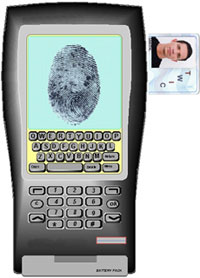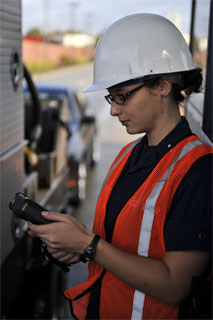Before asking the industry to invest in Transportation Worker Identification Credential (TWIC) readers, the Department of Homeland Security should reassess the effectiveness of the entire program.
That’s the consensus of many industry comments on the U.S. Coast Guard’s proposed TWIC reader requirements. The Coast Guard solicited public comments via its website as well as public meetings. The comment period was extended 30 days until June 20, 2013, to allow for full industry participation.
 |
|
Courtesy TSA The display on an electronic TWIC card reader. |
As part of the proposed rules, the Coast Guard classified vessels and facilities into three risk groups, prioritizing which vessels and facilities would be required to install and operate the readers and which could voluntarily install readers or rely on visual verification. Readers would be required only in the highest risk group that consists of vessels that carry certain dangerous cargoes in bulk, vessels certificated to carry more than 1,000 passengers and towing vessels that tow barges engaged in either of the first two activities.
The International Longshore and Warehouse Union was among the commenters who said that the entire TWIC program should be reconsidered before rules on readers are implemented.
“We urge the Department of Homeland Security to take a step back and order a neutral assessment of the efficacy of the TWIC program as a whole before imposing reader requirements on maritime employers and their workforces and adding to the program’s already high costs,” Leonard Carder, the union’s attorney, wrote in his comments.
Carder mentioned the likelihood that port facility owners would reduce their security forces to offset the cost of the TWIC readers, leading to reduced security from human interaction on a daily basis.
Other commenters cautioned that the Coast Guard should keep the TWIC program focused on identification verification rather than having it become an all-purpose ID card.
On smaller vessels that would not require a reader, mariners would use the TWIC as a “flip pass,” or show it to security officers to board the vessel and gain access to secure areas.
John Groundwater, executive director of the Passenger Vessel Association, in his comments asked the Coast Guard to remember that the “purpose of the TWIC reader is to ensure that the TWIC remains valid … just because an employee holds a TWIC, it does not automatically grant unescorted access into a designated secure area.”
Groundwater noted that many passenger vessels have secured areas separated by unsecured areas, so crew must walk through the passenger area moving between the engine room and pilothouse many times per day, for example.
“In most cases the TWIC holder does not enter a secure area of a vessel and facility at the beginning of the shift and stay there,” Groundwater said.
The King County (Wash.) Ferry District operates three water taxis on Puget Sound. Paul Brodeur, director of the county’s marine division, noted that access to the secure areas on the vessels is not manned, so “there would be no one to ‘flash’ their TWIC to.”
The Offshore Marine Service Association asked the Coast Guard to reconsider the rule that would require inland fleeting areas that receive barges carrying certain dangerous cargoes to install a TWIC reader. Sarah Branch, director of government relations, noted that these fleets are “merely parking lots for barges” often without a nearby facility or even access to land.
Also, towboat crew changes would be impeded by crews having to run the TWIC through a reader before boarding a vessel that already has its own security requirements, Branch added.
The Coast Guard rule proposal included additional requirements associated with electronic TWIC readers — recordkeeping requirements for those owners and operators required to use the reader and security plan amendments to incorporate TWIC requirements.

